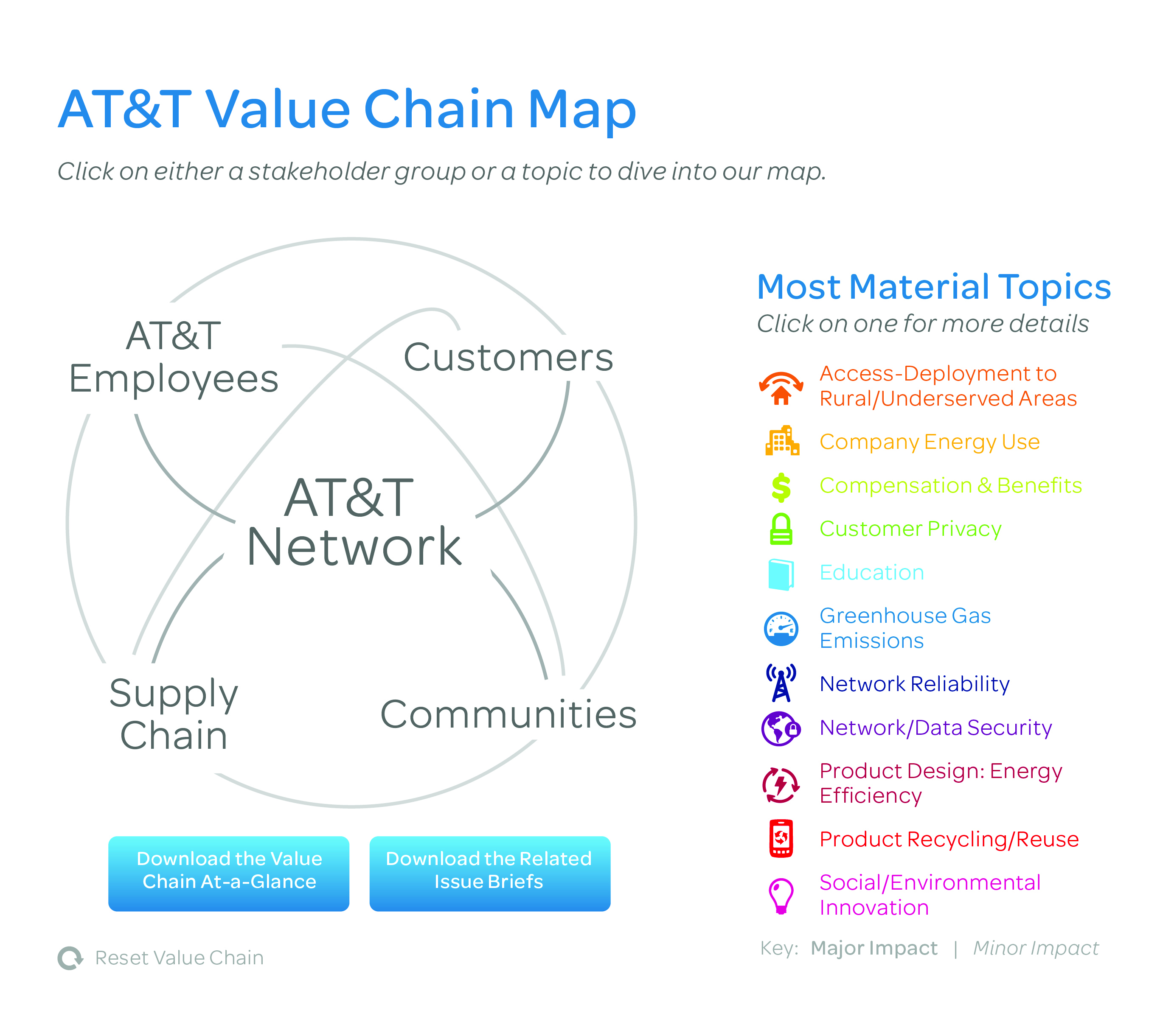Integrating corporate citizenship across the value chain
- Tue Aug 11 15:30:00 UTC 2015
- Colleen Olphert
The following member spotlight is excerpted from the most recent issue of The Corporate Citizen. To learn more about how you can focus resources and attention on the issues most important to your company’s stakeholders and business context, consider joining us for our CDP Reporting: Disclosing Environmental Impacts course.
Today, consumers are likely to hold firms responsible for the impacts of their products, regardless of where within the value chain the impact occurs. That’s why many companies are taking steps now to ensure that their corporate citizenship objectives are shared by their suppliers and business partners.
A value chain is the full range of activities—design, production, marketing, distribution—that businesses go through to bring a product or service from conception to delivery. For companies that produce goods, the value chain starts with the raw materials used to make their products.
Whether a company is sourcing materials, designing environmental initiatives, or navigating global labor standards, the best way to integrate corporate citizenship and ensure it adds the greatest possible value and meets the needs of the communities in which it operates is by understanding its value chain and stakeholder expectations. This knowledge will enable the organization to address risks and identify new opportunities.
Here is how two companies are integrating corporate citizenship throughout their value chains.
Target: designing value
As one of the largest mass retailers in the United States that manufactures nearly half of its own brand products, Target understands the importance of all aspects of their supply chain. By working with vendors to source products from more than 3,000 registered manufacturing facilities in 49 countries, Target’s value chain is extensive. Several years ago, Target conducted its first formal materiality assessment to identify, evaluate, and prioritize the top corporate citizenship issues for the company and its stakeholders. In 2014, Target revisited its materiality results and has identified the following key priorities where the company has focused its corporate social responsibility efforts and goals over the past several years:
- Climate change and resource scarcity
- Value chain (material use, responsible sourcing, and social compliance) • Transparency • Corporate giving
- Health and well-being
- Great place to work
- Safety and preparedness
“Considering the big picture, putting our guests first, and imagining outcomes are all essential practices of good design, and they are also essential to practicing corporate social responsibility,” said Kate Heiny, director of sustainability at Target. “Design is where our promise to the world begins—and where our value chain begins, too. We strive to make corporate citizenship a key business strategy of the company. At Target, our purpose is to fulfill the needs and fuel the potential of our guests. Everything that we do in corporate social responsibility ladders up to that company purpose.”
Each year, Target conducts a daylong risk summit to examine current and potential issues such as child labor in overseas factories or pressure to increase the minimum wage.
Examples of ways Target uses tools and partnerships to drive change and innovation to meet guest needs:
- Creating the Sustainable Product Index as a tool to help establish a common language, definition, and process for qualifying what makes a product more sustainable. Target has begun collecting product information from vendors and will use this data to inform its merchandising and product placement decisions for 2015 and beyond.
- Co-hosting, with Walmart, the Beauty and Personal Care Product Sustainability Summit with the purpose of bringing together key value chain partners to fast track a conversation about product sustainability in order to drive more necessary change within this category.
- Addressing unsafe working conditions for garment workers in Bangladesh by partnering with 26 other retailers in the United States and Canada in the Alliance for Bangladesh Worker Safety, which is dedicated to elevating safety conditions through measurable and sustainable actions.
- Joining the Sustainable Apparel Coalition—an organization working to reduce the environmental and social impacts of apparel, textile, and footwear products around the world, and creators of The Higg Index, a tool used to measure and improve environmental performance. Target began asking vendors making Target-brand products to use The Higg Index in 2012, and the results of their self-assessments are part of its annual vendor scorecards.
- Communicating its expectations of vendors clearly from the start through its Standards of Vendor Engagement (SOVE)—nine firm principles stating how the company expects vendors to treat workers and the environment.
- Its ongoing response to its 2013 data breach, which includes becoming the first retailer to join the Financial Services Information Sharing & Analysis Center (FS-ISAC), a nonprofit initiative developed by the financial services industry to help facilitate detection, prevention, and response to cyberattacks and fraud activity.
AT&T: mapping the value chain
Like Target, AT&T’s value chain is broad and diverse. AT&T’s services range from telephone service, advanced mobile services, next-generation TV, and high-speed Internet services to business solutions such as a highly secure mobile cloud and corporate network management. With nearly a quarter million employees and more than 120 million customers—including many of the world’s largest corporations—AT&T employees, customers, supply chain, and communities are not only part of the AT&T network, but also are connected to each other in a variety of ways.
At AT&T, corporate citizenship comprises nearly 50 social, environmental, and governance topics for which the company reports goals, key data, challenges, and opportunities. Understanding how these 50 topics interconnect, and where they have the most impact inside and outside the company, requires a big-picture perspective that can be difficult to find for a company of AT&T’s size.
“We are such a complex business, we often have to ask ourselves: How do we account for someone who is a customer but also a supplier? How do we account for the fact that our employees are buying from some of the other companies that are in our value chain?” said Jenny Robertson, director of sustainability at AT&T Inc.
Last year, AT&T created a map of the company’s value chain in order to answer that question.
“The value chain map is our ‘big picture’ that helps you see how each issue affects different parts of our value chain, and how those people are connected as well,” said Robertson.
AT&T likens the value chain to an interconnected web. Employees, customers, supply chain, and communities are not only part of the AT&T network, but also are connected to each other in a variety of ways. The value chain map shows five main groups—suppliers, operations, employees, customers, and communities—and how each one is affected by the top 11 issues identified in the company’s materiality assessment. It also demonstrates how each member of the value chain is linked to others, as well as how and where environmental and social issues affect the value chain.
“Big challenges present big opportunities,” said Robertson. “We’re working to tackle tough issues, including social matters such as the high school graduation rate and veteran hiring, environmental imperatives such as reducing energy and water use, and technology-related priorities such as ensuring that our products and services are used responsibly.”
Below are a few of the initiatives AT&T has in place to address these challenges:
- Education: AT&T Aspire, the company’s signature philanthropic initiative, is committed to investing $350 million in education between 2008 and 2017 in an attempt to improve the high school completion rate and ultimately support a national graduation rate goal of 90 percent by 2020. Employees are encouraged to engage by mentoring students at risk of dropping out through their Aspire Mentoring Academy— with a goal of one million hours of mentoring by the end of 2016.
- Veteran hiring: Veteran hiring has been a longstanding commitment of AT&T’s recruitment programs; in November 2013, the company expanded a previous goal and committed to hiring 10,000 veterans and their family members over the next five years.
- Environment: AT&T has taken a number of steps to lessen its environmental impact. It has built a strong energy efficiency program, and undertaken a multiyear project with the Environmental Defense Fund to explore water use in cooling towers that resulted in potential savings of 14–40 percent in trial sites. With one of the largest commercial fleets in the nation, AT&T is committed to finding more efficient, cleaner methods for powering its fleet, including the use of alternative-fuel vehicles.
- Product safety: More than 200,000 crashes a year involve drivers who are texting. Through the It Can Wait program, AT&T has committed to raising awareness and changing behavior surrounding texting while driving.
- Supply chain: AT&T’s suppliers play an important role in the company’s sustainability through their influence on issues like energy efficiency, alternative energy use, process improvement, and packaging. By the end of 2017, AT&T expects that top suppliers will achieve an average score of 80 percent or higher on its sustainability scorecard, which covers four key categories including policy breadth, rigorous goals, reporting transparency, and supply chain governance.
- Product reuse and recycling: Americans recycle just 11 percent of the more than 150 million phones that reach the end of their life spans each year. AT&T is engaging with suppliers to design phones that are easier to recycle, and collects products for recycling.
Connecting the value chain to corporate citizenship
It is clear that stakeholders are holding companies responsible not only for their own actions, but for the actions of their suppliers and business partners as well. By examining their value chain, from raw materials to end products, companies like AT&T and Target are well positioned to engage stakeholders, manage product life cycles, operate strict codes of conduct, and report transparently—ultimately managing risk and driving reputation.
If you would like to learn more on this topic join us for our CDP Reporting: Disclosing Environmental Impacts course.


